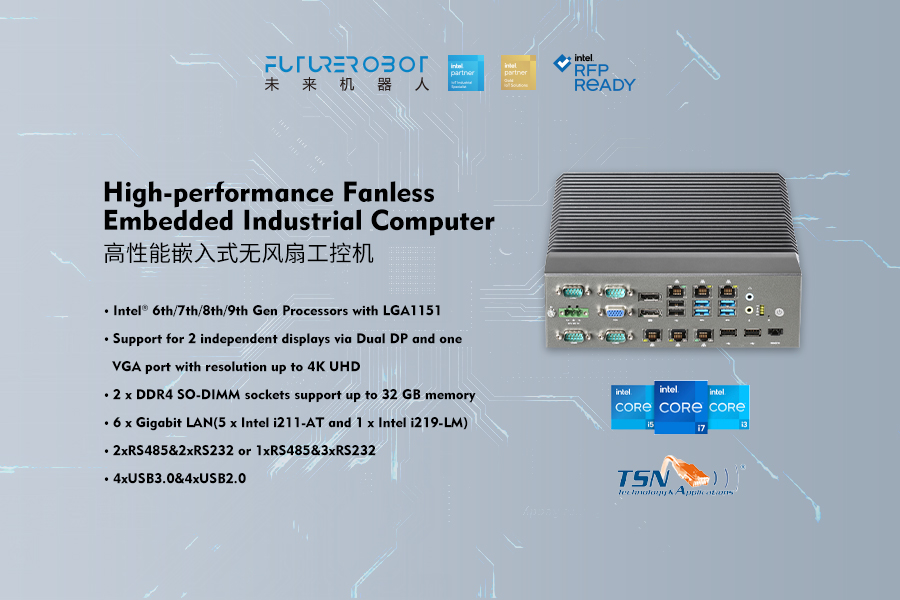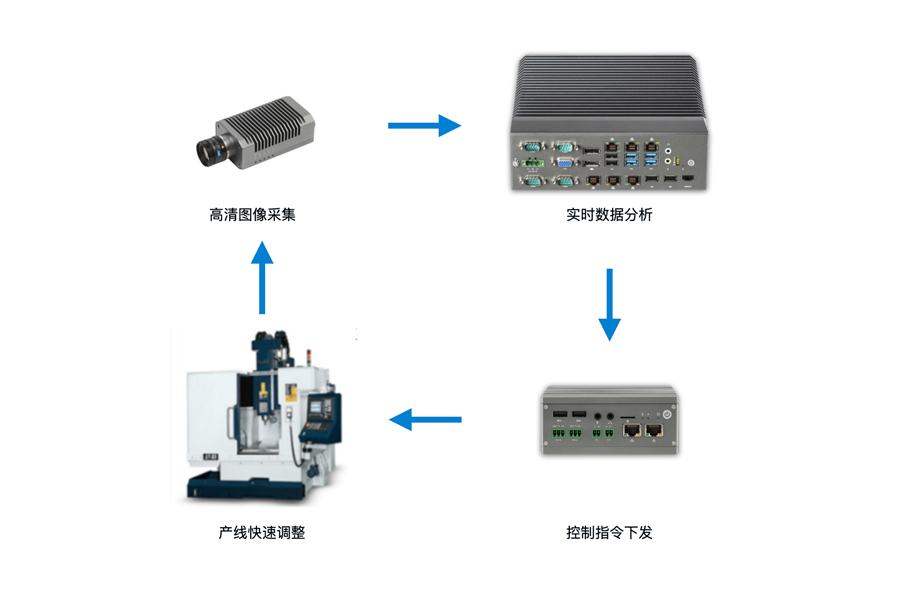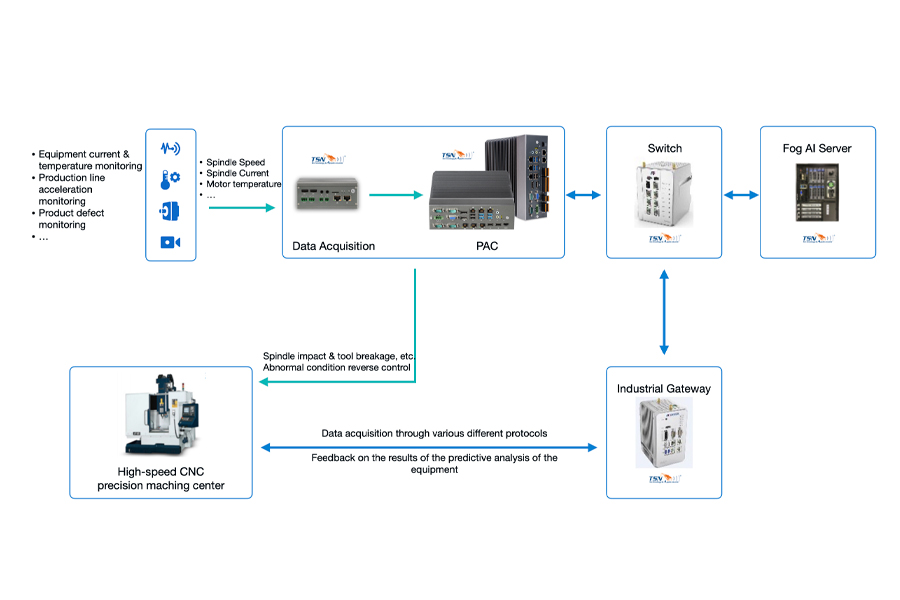Intelligent manufacturing solution using Future Robot IPC based on Intel's innovative technology and TSN network
Background
In the process of transformation of manufacturing enterprises in intelligence, networking and digitization, we often encounter traditional OT systems with devices from different vendors, which use different communication protocols and require complex protocol conversion when connecting with each other. Considering the safety and robustness of the system, the traditional OT system and IT system are often designed independently, and many manufacturing enterprises have to face a lot of work of equipment data integration and system fusion when doing intelligent manufacturing upgrade.
Now we can integrate data between different devices in different industrial sites into the same network with the help of a network such as TSN, enabling IT and OT convergence in industrial sites while maintaining system robustness and security.
Relative Technologies
Future Robot and its customer Fox Industrial Internet (FII) have worked together to create a set of intelligent manufacturing solutions based on TSN networks using products such as the E512 fanless IPC, V510 motion and vision controller and V300 edge node based on intel's innovative technology, which are now used in many industrial sites in China such as CNC machining, metal welding, precision manufacturing, etc.
This solution uses products and technologies based on the Intel Coffee Lake platform and Intel Apollo Lake platform, Intel Cyclone FPGA and Intel Ethernet Controller. For TSN networks, Future Robot's IPCs are powered by new Intel® Core™ processors and incorporate specialized Intel® Time Coordinated Computing (Intel® TCC) technology to minimize network or system latency and meet the manufacturing industry's needs for critical real-time computing applications in the manufacturing industry.
Take the E512 series IPCs adopted Intel Core CPUs as an example, it can change different configurations according to performance requirements, supports dual HD independent display, has 6 gigabit network ports with Intel independent NIC chips, all supporting TSN network functions, which can be flexible for networking, data acquisition and processing tasks.

Solution
As an open protocol standard (IEEE 802.1), TSN network can eliminate compatibility issues between devices from different vendors, making it easier to connect devices in the industrial IoT and more advantageous in terms of data transmission bandwidth, breaking the boundary between control systems and analysis systems in traditional manufacturing production lines and making AI applications easier to deploy in industrial sites. At the same time, the priority control and data security mechanisms brought by the hardware devices can also provide the guarantee of high reliability required by the production line.
By building an automated defect inspection system with a Computer Vision (CV) system and a Motion Control (MC) system, FII has applied this solution to a Computer Numerical Control (CNC) factory, and its typical workflow is shown below. After the product is captured by the industrial camera, the image is sent to the vision processing system deployed in the edge server or cloud platform for real-time processing. The inspection system built on CV algorithm or deep learning method will quickly determine whether the product meets the quality requirements, and send control instructions to the production line to perform subsequent operations such as shutdown.

With the help of TSN network, the whole system has the characteristics of high data synchronization and low network latency, promoting the integration of IT and OT systems. Real-time data from different devices on the production line can be centralized through a unified network, data processing and analysis can be performed on a unified data platform, and the results can be sent down to each device on the production line for execution.
By adding various types of sensors at key locations such as toolholders, spindles and power supplies, the solution solves the abnormal conditions such as tool breakage and misalignment that can occur from time to time during the machining process of CNC machines. This solution can use data collectors for real-time data collection, upload to Programmable Automation Controller (PAC), and make fast reasoning according to the algorithm model, and then reverse control the abnormal situation accordingly, forming a closed-loop network for abnormality detection.

Through the switch, data from the edge devices can be uploaded to a dedicated Fog AI server in the solution for model training, and the resulting models are then sent down to the edge via the switch for inference and execution. Thanks to a series of time synchronization and traffic scheduling mechanisms provided by the TSN network, it is possible to make the information transmission of the above systems more accurate, efficient and controllable. When congestion may occur within the closed-loop network due to excessive data volume, data flow transmission between devices can be based on established rules to ensure that high-priority data, such as control instructions, can be delivered faster. The more devices in the production line that can support the TSN network, the more obvious the advantages of the TSN network and the more intelligent it is for the entire manufacturing process.
In the CNC machining process, there is an important parameter of the tool head that plays a key role in the accuracy of the product, it is the "golden life" of the tool, when the tool head exceeds its golden life, it is impossible to ensure the accuracy of the product machining. The golden life of a tool head depends on a series of factors such as machining method, production line temperature, current, etc. Therefore, we can use a series of sensors already deployed in this solution to collect the vibration curve, temperature, current and other data of the tool head, and upload it to Fog AI server for training in real time through TSN network to get a prediction model of the tool head life, and make a predictive analysis of the life and usage of the tool head in CNC equipment. The predictive analysis and judgment of the life and usage of the toolheads in the CNC machine can be made, so that the toolheads can be replaced in time when they reach their golden life and ensure the machining accuracy of the products. In turn, we can manage the golden life of thousands of tool heads and design the optimal replacement schedule to avoid productivity loss due to downtime for tool head replacement.

Thanks to the excellent performance of Future Robot IPC products based on Intel® architecture and fast and efficient TSN network, this solution can effectively promote the integration of industrial OT systems and IT systems, ensuring industrial IoT with high efficiency data transmission while taking into account industrial-grade robustness and reliability, thus bringing many advantages to Industrial F&T's smart manufacturing solutions.
1) Improve the yield rate of manufacturing lines: By deploying IoT devices to the production line, and with the efficient transmission capability provided by TSN network, it is possible to effectively control when abnormalities occur in the production line, and also to predict the usage of devices using predictive analytics and other AI methods.
2) Enhanced industrial IoT transmission efficiency: In some scenarios, network congestion, data packet loss or retransmission caused by excessive data volume and other reasons often occurred in the past, and the data transmission efficiency was lower than 90%. And after adopting the new solution based on TSN network, the data loss problem is effectively controlled and the data transmission efficiency is improved to more than 99%.
3) Cost reduction and productivity improvement: The TSN network supports AI applications such as anomaly detection and predictive analysis, enabling production lines to effectively reduce the number of downtime inspections and improve productivity based on more scientific equipment management solutions. In some scenarios, each machine must be equipped with one operator, but with the introduction of the new solution, one person can operate multiple machines.
Future Robot Technology Co., Limited (Future Robot in short) is a high-tech innovation enterprise focusing on Intelligent Manufacturing and Artificial Intelligence. Future Robot, with strong R&D capability and market demand-orientation, design and provide worldwide enterprises and individual users with embedded products which are for Industrial Automation, Robot, Machine Vision, Medical Application, Intelligent Transportation, Education and Internet of Things applications.
Expert team with rich experiences in Machine Vision, Motion Control and Edge Computing:
Hardware engineering team
- x86, FPGA, DSP, Layout and testing Engineers
Software engineering team
- BIOS engineers, FPGA, DSP, Algorithm software engineers and system development engineers.
Industrial and structure design engineering team
- structure design, multi board and model design

As a member of Intel IoT Solutions Alliance and partner of Intel IoT RFP Ready Kits, Future Robot Technology Co., Limited aim to provide reliable, high efficient and customized solutions for the customers worldwide.
 ApplicationsProcessorsFeaturesApplicationsRugged Embedded Computing
ApplicationsProcessorsFeaturesApplicationsRugged Embedded Computing IOT Logistics Gateway
IOT Logistics Gateway ProcessorsFeatures
ProcessorsFeatures Sales and SupportSales and Support
Sales and SupportSales and Support ApplicationApplication
ApplicationApplication About usAbout us
About usAbout us














